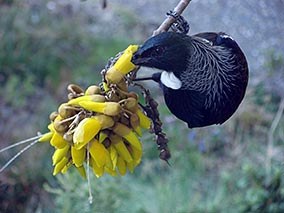Before embarking on a planting project it’s important to be clear about what you want to achieve. This will affect the size and scope of your project. We’ve outlined some key questions to help you get started.
What do you want to achieve?
 Tui feeding on kowhai at Rance’s place.Some ideas for projects include:
Tui feeding on kowhai at Rance’s place.Some ideas for projects include:
- Attracting native birds, for example, to a back garden, school or kindergarten.
- Using native trees as a shelterbelt.
- Restoring native habitat.
- Landscaping with native plants.
- Creating a pond.
Find out what native trees you can plant to attract native birds to your place. See our planting guide to native shelterbelts in Southland.
Find out more about establishing a native garden at your school.
Restoring native habitat
Think about the following questions before planning your project:
- How much time and money do you want to invest?
- What do you already have? For example, a stand of mature native trees, a farm wetland or a bare paddock?
- What needs doing? For example, fencing, planting, weed control?
- How and where can you get help and advice?
- Can you include nearby natural areas in your project?
- How does your area compare with natural areas nearby?
Where to start
If you’re new to this it may be a good idea to start with a small site. If you have a choice of sites on your land (for example, there are several forest fragments), select an area of native bush for restoration based on its:
- Size - larger sites can generally maintain more native species.
- Shape - sites that are squarish or circular will be cheaper to fence than narrow sites of the same size, and they will be less affected by edge effects.
- Location - fragments close to other native areas will have a better chance of being colonised by birds and native seeds; fragments that cross your boundary may enable you to protect a larger area with your neighbour’s help; fragments next to streams or wetlands can help protect them from nutrients in water running off the land.
- Condition - fragments with the least problems (for example, few weeds and pests, fenced or partly fenced) will generally provide the best return for effort.
- Maturity - consider protecting areas with larger, more mature trees first - they may be hundreds of years old, so they’re harder to replace in our lifetime.
- Access - you’ll need good access for fencing, pest control, planting, and visitors.
- Special features - some fragments have rare or threatened species, culturally important species or other special features that you may wish to look after and enjoy.
Plan of action
We’ve put together some simple steps for a restoration project to help you with the planning process. See figure below:
 Planning your project.
Planning your project.
Find out more
Ready to start restoring your patch? Find out more about habitat restoration in Southland and how you can get involved. Learn about the different habitat types and what grows best where. See our information on looking after your patch, including:
